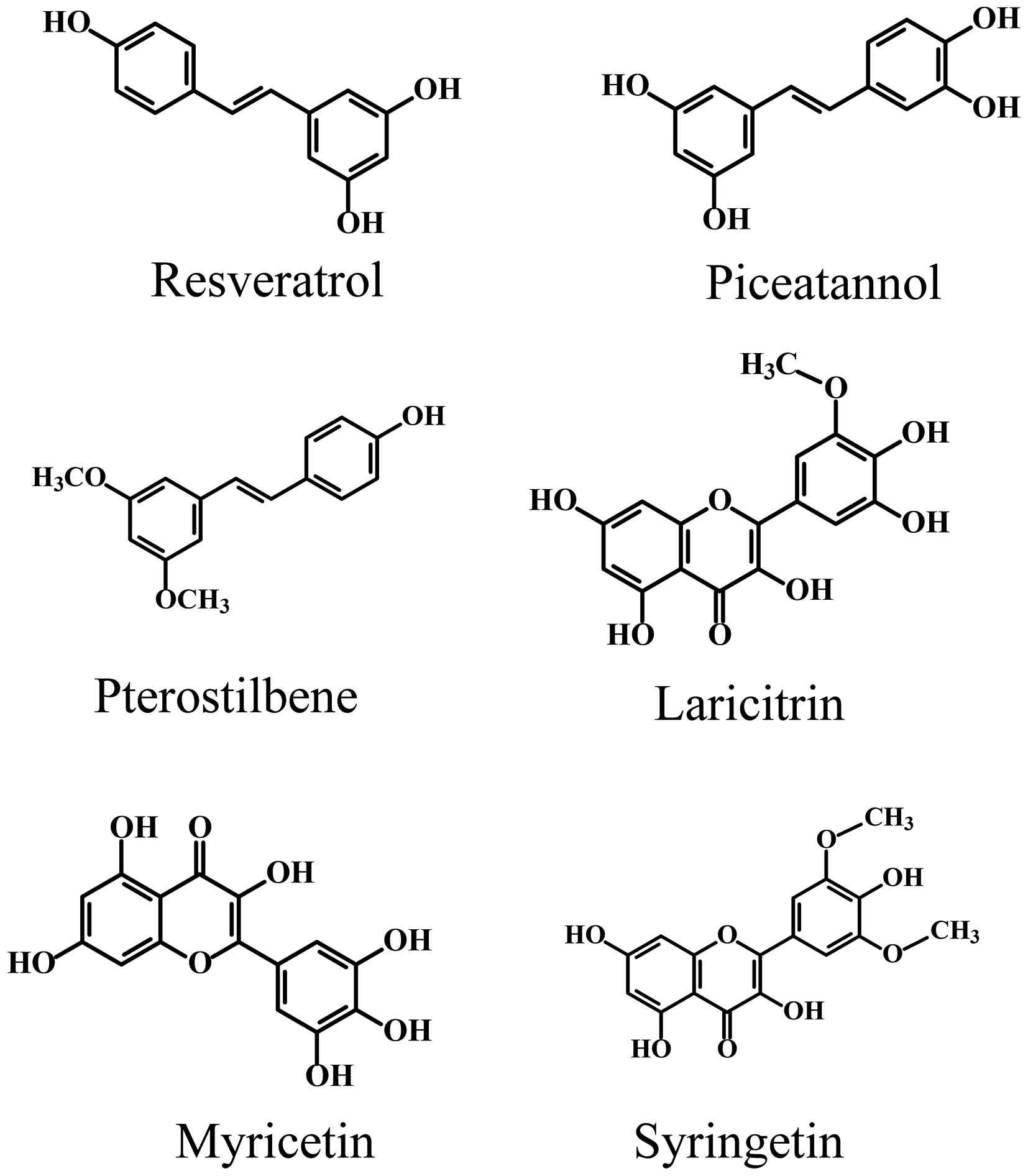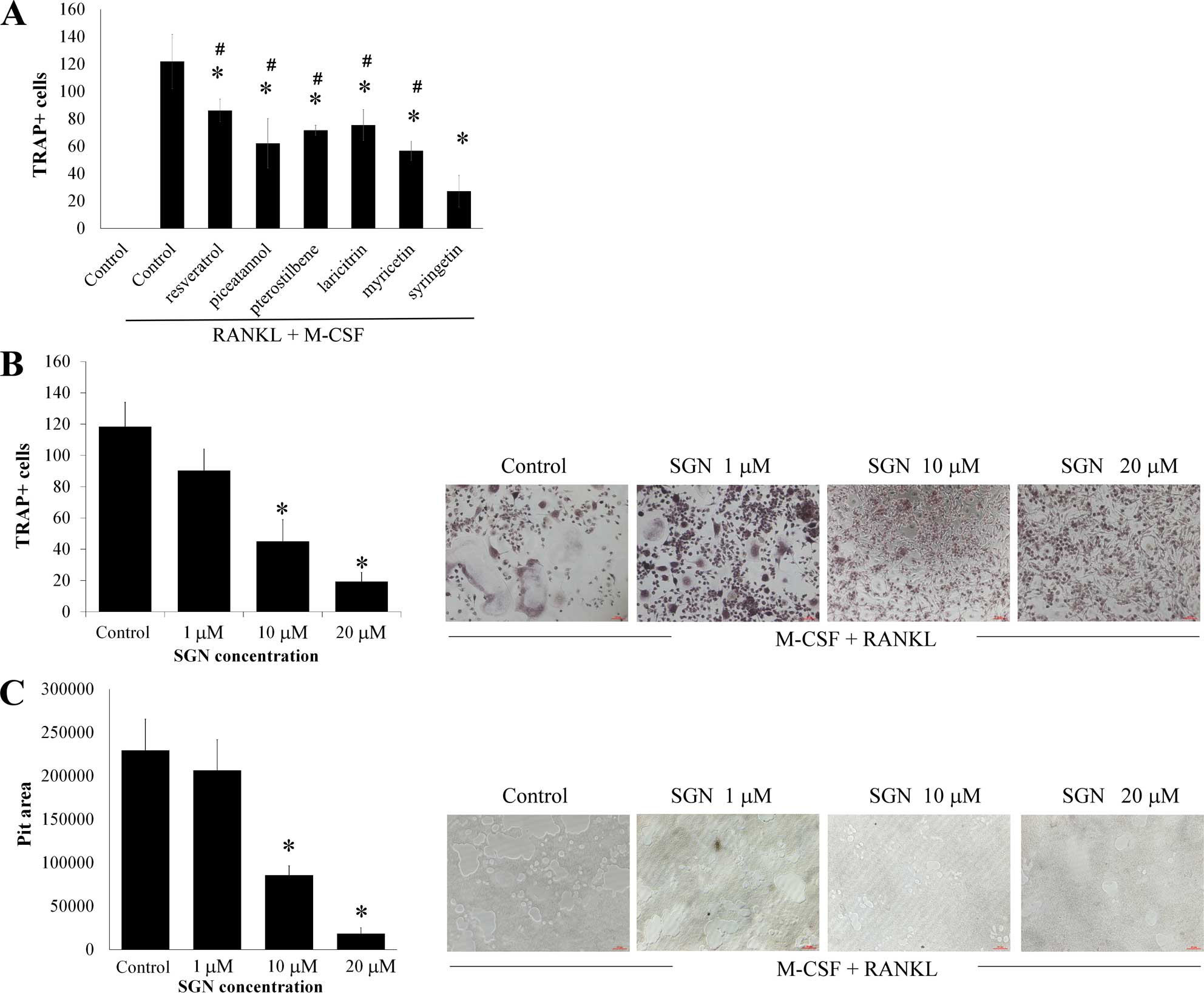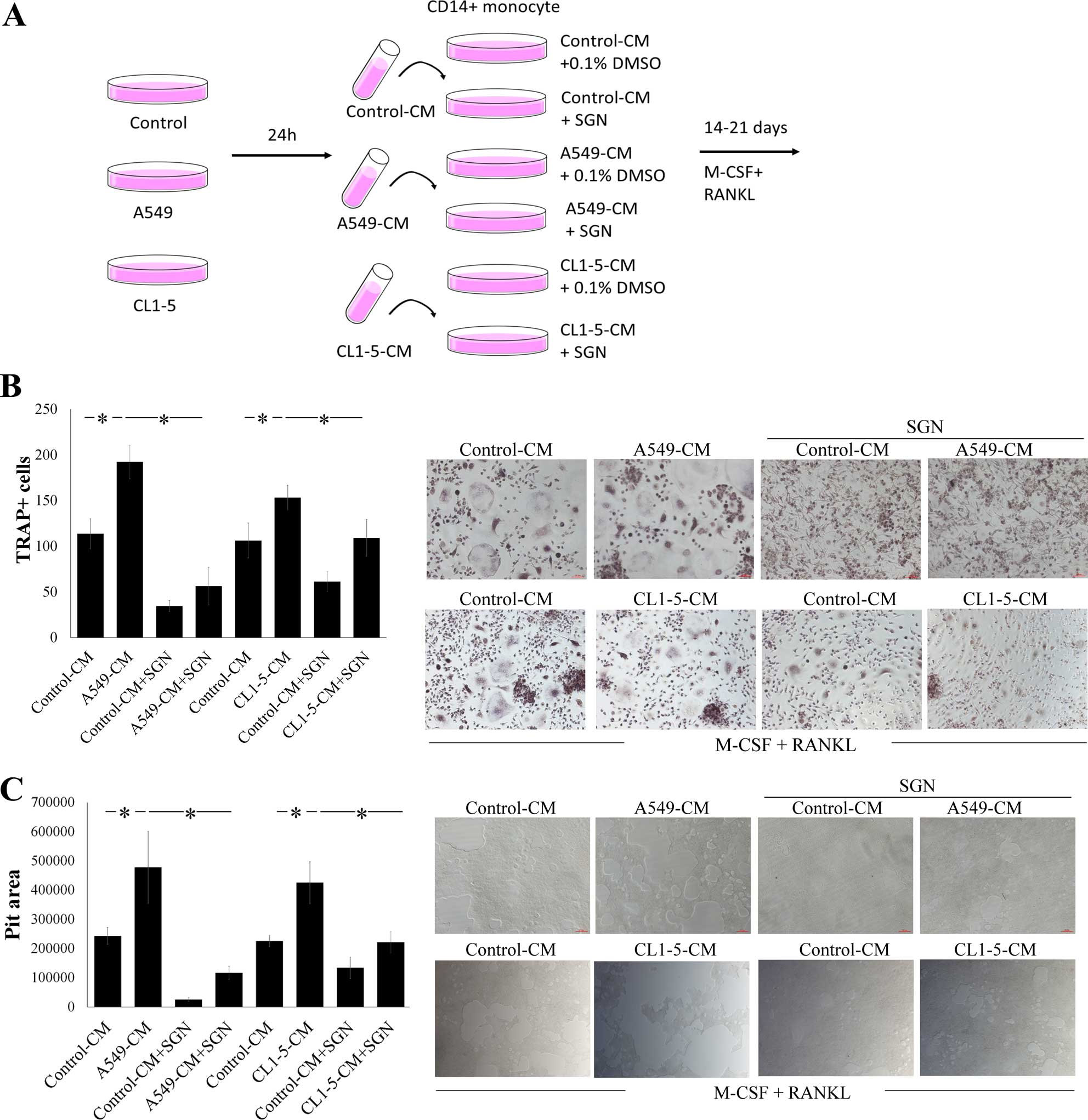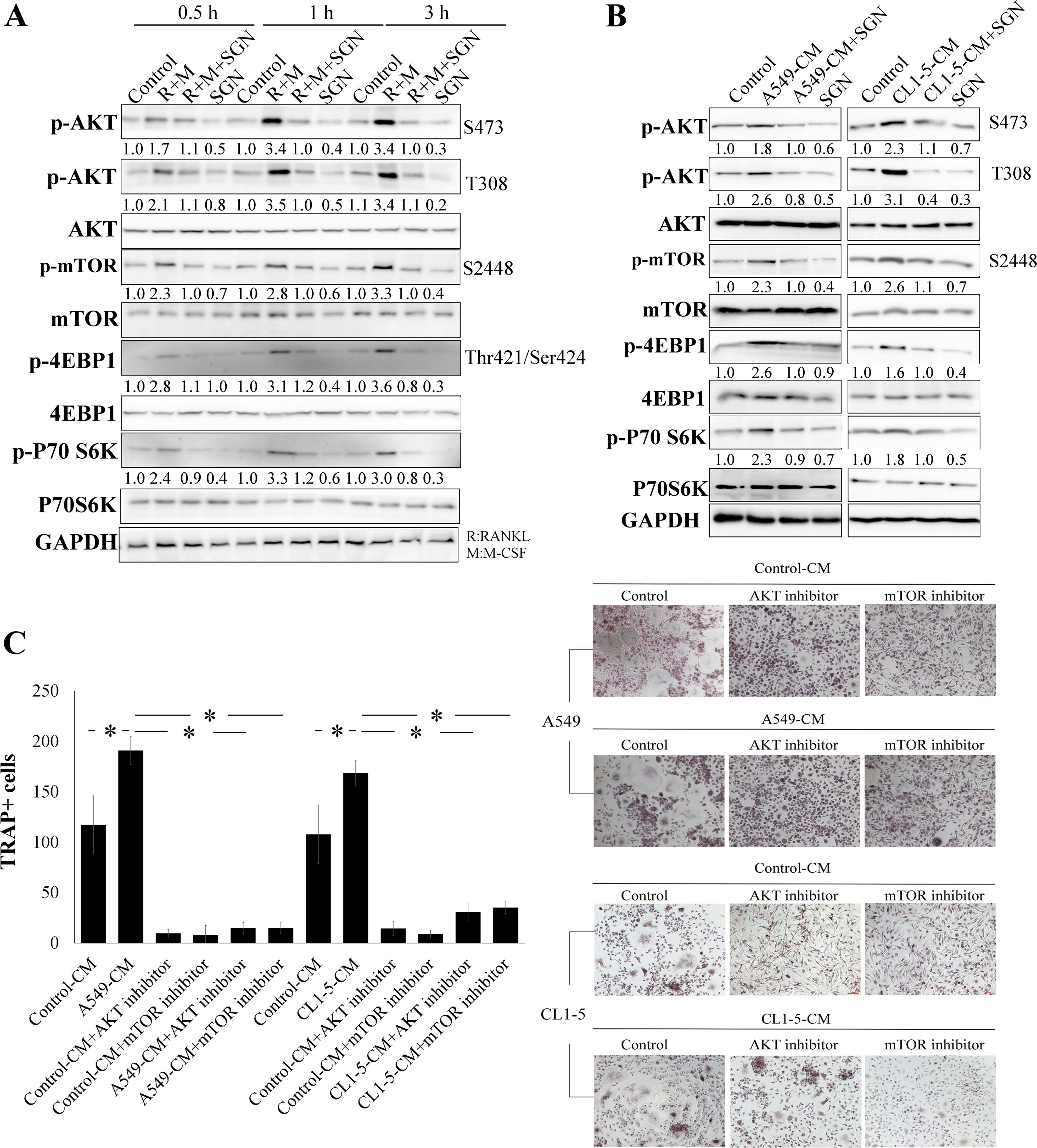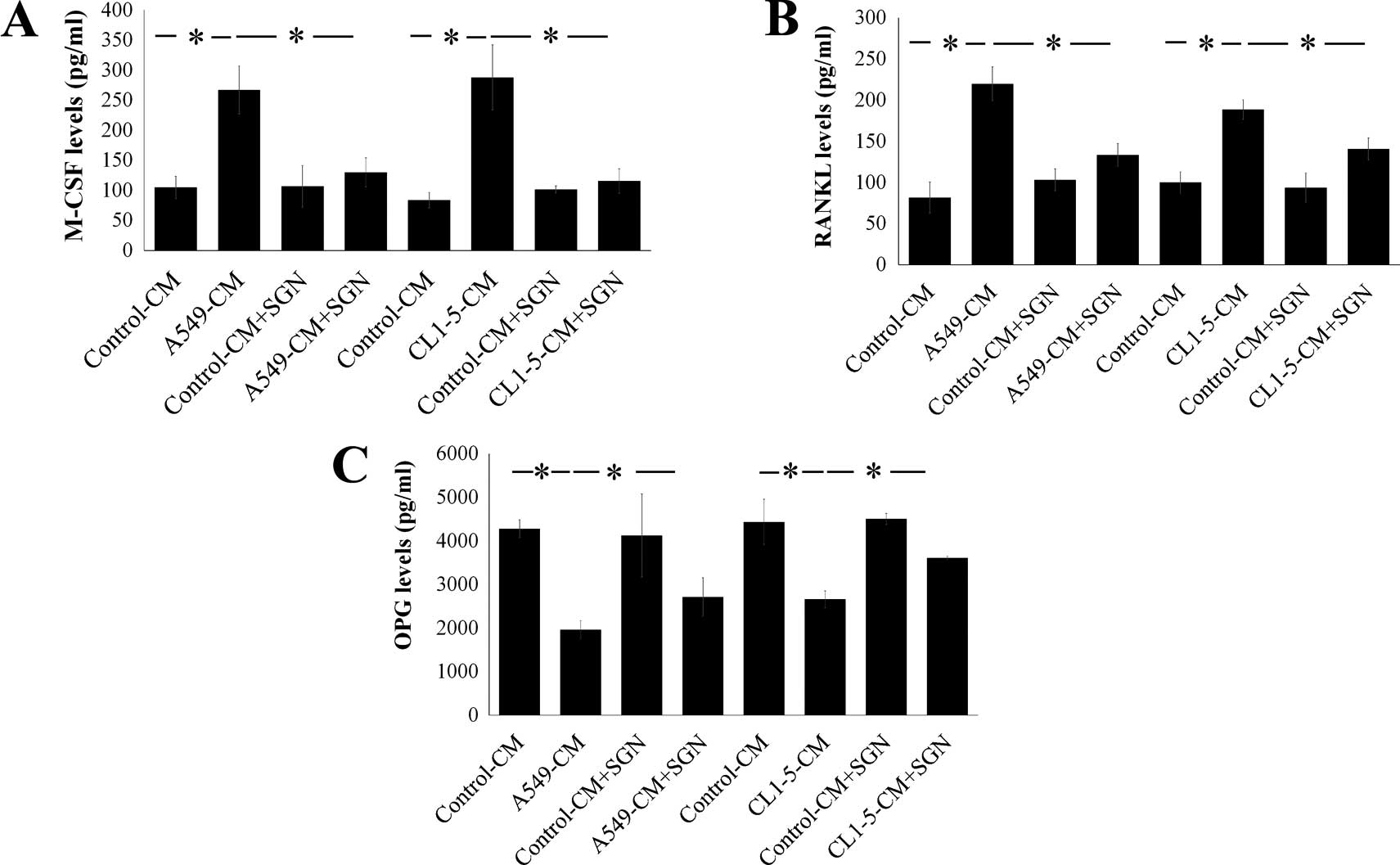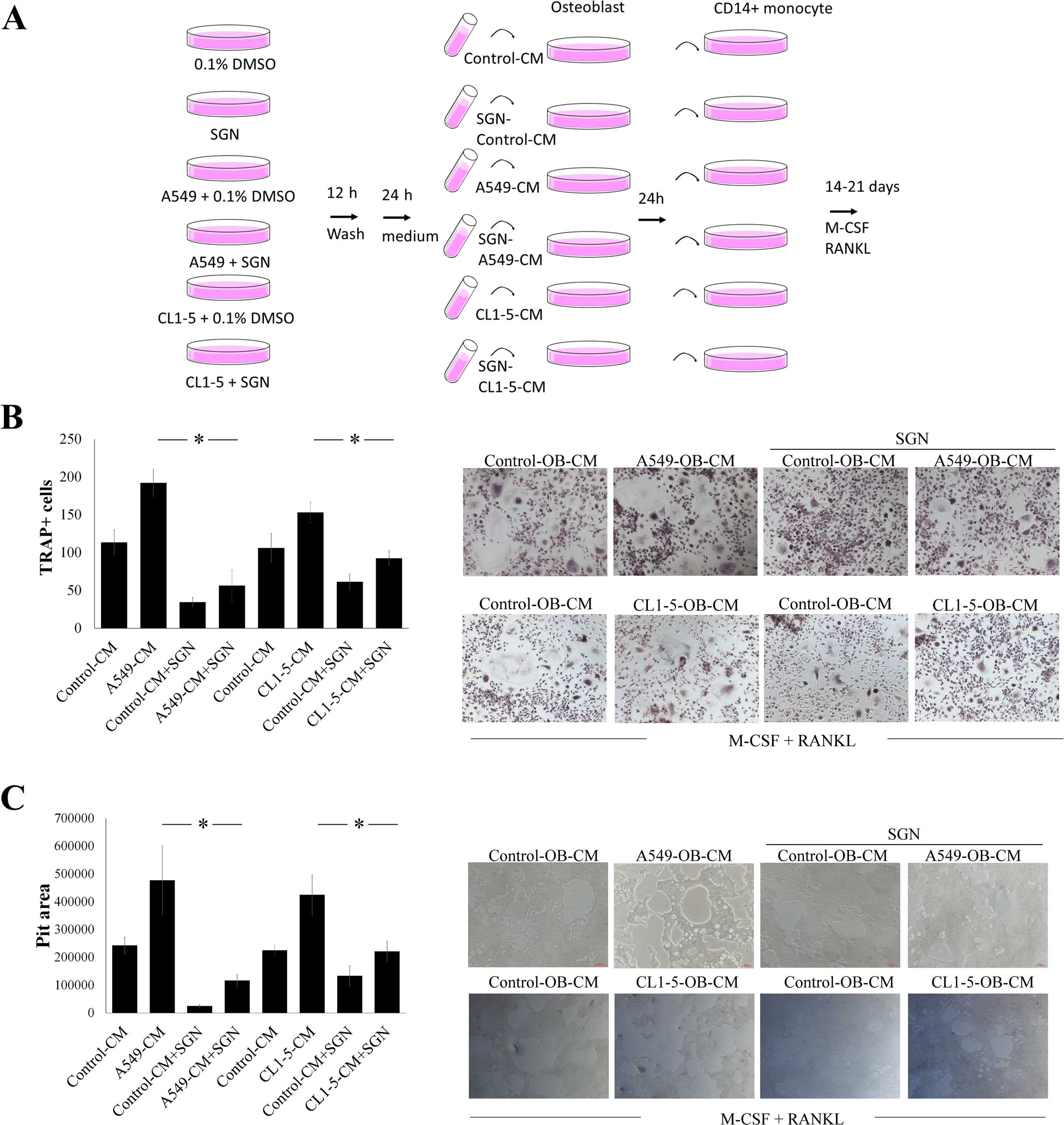Syringetin suppresses osteoclastogenesis mediated by osteoblasts in human lung adenocarcinoma
- Authors:
- Published online on: June 4, 2015 https://doi.org/10.3892/or.2015.4028
- Pages: 617-626
Abstract
Introduction
Lung cancer is the leading cause of cancer-related mortality, with an extremely poor prognosis worldwide (1–3). It has also been reported that ~30–40% of patients with lung cancer eventually develop bone metastasis, not only impairing quality of life but also increasing the incidence of cancer-related death (3–5). Osteolytic metastasis develops in certain types of cancer, such as lung cancer, and is featured as upregulated osteoclast activity and downregulated osteoblast capacity, resulting in bone destruction (6–8). Therefore, novel therapeutic strategies for preventing and treating bone metastasis in lung cancer should be developed.
As is well known, cancer cells secrete various factors which enhance osteoclastic resorption, and the release of certain factors from the skeletal matrix has been proven to enhance bone metastasis (9,10). There are several factors contributing to cancer cell migration to bone, such as stromal-derived factor-1, monocyte chemotactic protein 1, and receptor activator of nuclear factor κB ligand (RANKL). Other factors enhancing cancer cell growth within bone, such as transforming growth factor-β (TGF-β) and parathyroid hormone (PTH)-related protein, have also been identified (11–13). Takiguchi et al reported that CXCL14 promoted bone metastasis through enhancement of cancer cell tropism to the bone and/or recruitment of bone marrow cells around metastatic cancer cells (14). Our recent study illustrated that lung cancer-derived IL-8 increased osteoclastogenesis via the phospholipase D signaling transduction pathway (15).
Grapes are a rich source of polyphenols, including stilbene and flavonol derivatives (16). Stilbenes, vine phytoalexins, are associated with the beneficial effects of drinking wine. Resveratrol, pterostilbene and piceatannol are naturally occurring stilbene derivatives (17). Previous studies have revealed that resveratrol and pterostilbene possess antioxidant, anti-inflammatory and anticancer properties (18–24). Moreover, even freeze-dried residue from red wine significantly inhibits bone resorption (25). Red grapes are rich in flavonols, a ubiquitous class of flavonoids, which along with other derivatives of flavonoids such as myricetin, laricitrin and syringetin (SGN), possess antioxidant effects (26–28). SGN (3,5,7,4′-tetrahy-droxy-3′,5′-dimethoxyflavone), a flavonoid derivative, exists in both grapes and wine (27–29). The SGN content of red grapes is 3.22% (27). Syringetin-3-O-glycoside is the major derivative present in red grapes, with syringetin-3-glycosides coexisting with corresponding free aglycones released by hydrolysis in wine (30). In a colorectal epithelial adenocarcinoma cell model, SGN was shown to inhibit cellular proliferation by decreasing cyclooxygenase-2 and cyclin D1 expression (31). Our previous study indicated that SGN stimulated osteoblast differentiation via the bone morphogenetic protein-2 (BMP2)/extracellular signal-regulated kinase 1/2 (ERK1/2) signaling transduction pathway (32). The present study demonstrated that SGN inhibited human lung adenocarcinoma A549 and CL1-5 cell-mediated osteoclastogenesis through the downregulation of the AKT/mammalian target of rapamycin (mTOR) signaling pathway. Moreover, SGN downregulated macrophage-colony stimulating factor (M-CSF) and RANKL expression in A549-CM-stimulated osteoblasts and inhibited osteoblast-mediated osteoclastogenesis.
Materials and methods
Chemicals
SGN and laricitrin were purchased from Extrasynthese (Genay, France); resveratrol, pterostilbene, piceatannol and myricetin were obtained from Sigma Chemical (St. Louis, MO, USA) (Fig. 1). These were dissolved in dimethylsulfoxide (DMSO) (Sigma Chemical) and stored at −20°C. Control cultures received the carrier solvent (0.1% DMSO). All other chemicals used were of the purest form available commercially.
Cell culture
Human lung adenocarcinoma A549 cells were obtained from the American Type Culture Collection (CCL-185) (Manassas, VA, USA) and cultured in F-12K medium containing 10% fetal bovine serum (FBS) (both from Gibco-BRL, Gaithersburg, MD, USA). CL1-5 human lung adenocarcinoma cells were generously provided by Dr Pan-Chyr Yang (Department of Internal Medicine, National Taiwan university Hospital) (33,34), and cultured in RPMI-1640 medium supplemented with 10% FBS and 1% penicillin-streptomycin (both from Gibco-BRL). Human primary osteoblasts were cultured in osteoblast growth medium (OBM) (both from Lonza, Walkersville, MD, USA). For conditioned medium (CM) collection, the A549 and CL1-5 cells were treated with vehicle (0.1% DMSO) or various concentrations of SGN for 12 h. After washing, fresh culture medium was added and cultured for another 24 h. The supernatants were collected, filtered (0.22-mm) and identified as A549-CM, SGN-A549-CM, CL1-5-CM and SGN-CL1-5-CM. Osteoblasts were cultured with A549-CM, SGN-A549-CM, CL1-5-CM or SGN-CL1-5-CM (20%) for another 24 h, then the supernatants were collected and filtered (0.22-mm). These supernatants were grouped as osteoblast-CM (OB-CM), A549-OB-CM, SGN-A549-OB-CM, CL1-5-OB-CM and SGN-CL1-5-OB-CM. All condition media were frozen and stored at −80°C, with a single thawing for study.
Osteoclast differentiation
Human peripheral blood, obtained from healthy adult volunteers, was collected in syringes containing 1,000 U/ml of preservative-free heparin. Peripheral blood mononuclear cells (PBMCs) were isolated by density centrifugation using Ficoll-Hypaque, and re-suspended in RPMI-1640 medium supplemented with 10% heat-inactivated FBS. The PBMCs were then plated and incubated overnight at 37°C. CD14+ monocytes were isolated using CD14+ mAb-conjugated magnetic beads (MACS MicroBeads; Miltenyi Biotec, Ltd., Bergisch Gladbach, Germany) according to the manufacturer’s protocol. The purity of CD14+ cells was 94–97%. Monocytes were grown in culture medium containing vehicle or tested compounds preset at 200 ng/ml human M-CSF and 100 ng/ml human RANKL (R&D Systems, Minneapolis, MN, USA) for 14–21 days. The medium was replaced every 5 days. The Institutional Review Board of the Kaohsiung Medical University Chung-Ho Memorial Hospital approved the study protocol, and all participants provided written informed consent in accordance with the Declaration of Helsinki. Osteoclast formation was measured by quantifying cells positively stained by tartrate-resistant acid phosphatase (TRAP) (Sigma-Aldrich, St. Louis, MO, USA). Briefly, the cells were fixed with formaldehyde for 30 min and then stained with naphthol AS-BI phosphate and a tartrate solution for 1 h at 37°C, followed by counterstaining with a hematoxylin solution. Osteoclasts were determined to be TRAP-positive staining multi-nuclear (>3 nuclei) cells by light microscopy. The total number of TRAP-positive cells and the number of nuclei/TRAP-positive cell in each well were counted.
Bone resorption assay
CD14+ monocytes were plated into a calcium phosphate apatite-coated 48-well plate for the bone resorption assay (Cosmo Bio Co., Ltd., Tokyo, Japan) in the same culture conditions as previously described. After a 14-day culture, each well was washed with saline. A solution of 5% sodium hypochlorite was left in the well for 5 min to detach the cells. The pit area in each well was determined by AlphaEaseFC software (Alpha Innotech Corporation, San Leandro, CA, USA).
Immunoblotting
CD14+ monocytes were pre-treated with vehicle control (0.1% DMSO) or SGN (20 µM) for 1 h or otherwise indicated times (time-dependent manner), and then M-CSF (200 ng/ml)/RANKL (100 ng/ml) was added for 0.5, 1 and 6 h. The expression of various proteins was assessed by immunoblotting. The cells were lysed on ice for 15 min by M-PER lysis reagent (Thermo Fisher Scientific, Waltham, MA, USA). The cell lysate was centrifuged at 14,000 × g for 15 min, and the supernatant fraction was collected for immunoblotting. Equivalent amounts of protein were resolved by SDS-PAGE (6–8%) and transferred to polyvinylidene difluoride membranes. After blocking for 1 h in 5% non-fat dry milk in TBS, the membrane was incubated with the primary Ab for 1–16 h (1 h for GAPDH; 16 h for phosphorylated AKT, mTOR, 4EBP1 and p70S6K; and total protein of AKT, mTOR, 4EBP1 and p70S6K). The membrane was then treated with the appropriate peroxidase-conjugated secondary Ab, and the immunoreactive proteins were detected using an ECL kit (Millipore, Billerica, MA, USA) according to the manufacturer’s instructions. All antibodies were obtained from Cell Signaling Technology (Beverly, MA, USA). To quantify immunoblot images on unsaturated bands, densitometric analysis was performed using AlphaEaseFC software.
Enzyme-linked immunosorbent assay (ELISA)
M-CSF levels were assessed by the M-CSF ELISA kit (R&D Systems). The RANKL and OPG levels in the osteoblasts were quantified using the DuoSet ELISA (R&D Systems).
Statistical analysis
Data are expressed as means ± SD. Statistical comparisons were carried out using analysis of variance. Significant differences (p<0.05) between two test groups were analyzed by the Student’s t-test.
Results
SGN exhibits a direct inhibitory effect on osteoclast differentiation and bone resorption activity
To explore whether the novel agents inhibit osteoclast development, the effects on osteoclast differentiation by various polyphenols, including resveratrol, piceatannol, pterostilbene, laricitrin, myricetin and SGN were assessed. Treatment of the CD14+ monocytes with M-CSF and RANKL caused formation of numerous TRAP-positive multi-nucleated osteoclasts (Fig. 2A), whereas osteoclast differentiation was significantly inhibited by resveratrol, piceatannol, pterostilbene, laricitrin, myricetin and SGN (20 µM). SGN showed the most significant inhibition of osteoclast differentiation in comparison with resveratrol, piceatannol, pterostilbene, laricitrin and myricetin. Consequently, we selected SGN as the model for exploring the mechanism of lung adenocarcinoma-related osteoclastogenesis. First, SGN treatment inhibited osteoclast differentiation in a dose-dependent manner (Fig. 2B). SGN treatment also substantially reduced bone resorption in a dose-dependent manner (Fig. 2C). These findings suggest that SGN inhibits osteoclast differentiation and reduces bone resorption activity in vitro.
SGN inhibits human lung adenocarcinoma-mediated osteoclastogenesis
Next, we evaluated the effects of SGN on lung adenocarcinoma-mediated osteoclastogenesis (Fig. 3A). The results showed that A549- and CL-1-5-CMs markedly promoted osteoclastogenesis (Fig. 3B). However, the osteoclastic effect induced by human lung adenocarcinoma A549- and CL1-5-CMs was markedly inhibited by SGN. Furthermore, A549- and CL1-5-CMs enhanced the bone resorption activity of the osteoclasts, yet this effect was also reduced by SGN (Fig. 3C). Both results indicate that SGN suppresses human lung adenocarcinoma A549 and CL1-5 cell-mediated osteoclast differentiation and bone resorption activity.
SGN suppresses osteoclastogenesis by inhibiting AKT/mTOR
To clarify the molecular mechanism involved in SGN osteoclastogenesis, signaling transduction pathways were investigated. Treatment of M-CSF/RANKL increased the phosphorylation of AKT and mTOR. The downstream targets of mTOR, p70S6K and 4EBP1 were also activated by M-CSF/RANKL, suggesting that the AKT/mTOR signaling transduction pathway was activated during osteoclastogenesis. The osteoclastogenetic inducers (M-CSF and RANKL) of AKT/mTOR expression were suppressed by SGN (Fig. 4A). Furthermore, both A549- and CL1-5-CMs activated AKT/mTOR expression (Fig. 4B). Through treatment with both AKT inhibitor IV and mTOR inhibitor (rapamycin) we further supported the role of AKT/mTOR in osteoclast differentiation and bone resorption (Fig. 4C and D). Both AKT and mTOR inhibitors also suppressed A549 and CL1-5-mediated osteoclasteogenesis (Fig. 4C and D). In short, SGN not only inhibited M-CSF/RANKL-mediated AKT/mTOR activation, yet also reduced the reinforcing effect of lung adenocarcinoma on this signaling transduction pathway (Fig. 4B). These results indicate that SGN inhibits the AKT/mTOR signaling transduction pathway, which is critical in osteoclastogenesis induced by both M-CSF/RANKL and lung cancer cells.
SGN attenuates the stimulatory effect of human lung adenocarcinoma on M-CSF and RANKL expression in osteoblasts
Osteoblasts play a critical role in assisting bone metastasis by increasing M-CSF and RANKL expression and decreasing OPG expression (35). To verify this, we examined the effect of SGN on secretions of M-CSF, RANKL and OPG in osteoblasts by lung adenocarcinoma, A549- and CL1-5-CMs, which markedly increased M-CSF and RANKL expression in the osteoblasts (Fig. 5A and B). On the other hand, A549- and CL1-5-CMs decreased OPG expression in the osteoblasts (Fig. 5C). SGN attenuated the stimulatory effect of lung adenocarcinoma on the expression of M-CSF and RANKL, and reversed the effect of lung adenocarcinoma on the suppression of OPG expression in the osteoblasts (Fig. 5A–C).
SGN reduces the enhancing effect of human lung adenocarcinoma on osteoblast-mediated osteoclastogenesis
The role of SGN in human lung adenocarcinoma-mediated interaction between osteoblasts and osteoclasts was further investigated (Fig. 6A). When compared with unstimulated osteoblasts, human lung adenocarcinoma A549 and CL1-5 cell-treated osteoblasts enhanced osteoclastogenesis. Although lung adenocarcinoma A549 and CL1-5 cells promoted osteoblast-mediated osteoclast differentiation and bone resorption, this effect was altered by SGN (Fig. 6B and C). These findings suggest that SGN inhibits the osteoblasts in lung adenocarci-noma-mediated osteolytic bone metastasis.
Discussion
Bone metastasis in lung cancer patients is a devastating event, since once it occurs, it markedly worsens morbidity and mortality rates (36,37). Sone and Yano demonstrated that compounds, bisphosphonates and reveromycin A, which potentially suppress osteoclast activity, were of benefit in treating lung cancer bone metastasis (38). Despite modern treatment strategies, 30–50% of patients still develop new bone metastases, skeletal complications and disease progression, emphasizing the necessity for novel therapies (39,40). Osteoclastic metastasis characterized by lung cancer bone metastasis and osteoclast differentiation could be a target for treatment strategy. Multi-modality therapy may be required for lung cancer bone metastasis (36–38). In the present study, SGN, a flavonoid derivative found in grapes and wine, was first investigated to determine its suppressive effects on osteoclast differentiation and bone resorption activity, stimulated either by osteoclastogenic factors or lung cancer cells. Furthermore, SGN was also found to inhibit the proosteoclastic effect in osteoblasts stimulated by lung cancer cells. This suggests that SGN possesses therapeutic potential in treating lung adenocarcinoma bone metastasis (Fig. 7).
The balance between osteoblasts and osteoclasts can be interrupted by metastasized cancer cells (6). Osteoblasts play vital roles in regulating skeleton physiology, since they are not only precursors of osteocytes, yet also influence osteoclast differentiation (41,42). Osteoblasts promote osteoclast differentiation from osteoclast precursors by producing M-CSF and RANKL (43). In contrast, osteoblasts inhibit osteoclastogenesis by secreting OPG, a decoy receptor for RANKL, to block the binding of RANKL to its receptors on pre-osteoclasts (44). Cancer cells modify the pattern of M-CSF, RANKL and OPG expression in osteoblasts, facilitating cancer cell-associated osteolytic bone metastasis (45). In the present study, human lung adenocarcinoma A549 and CL1-5 cells upregulated M-CSF and RANKL expression yet downregulated OPG expression in osteoblasts, thereby increasing osteoclast differentiation and bone resorption activity. This upregulation of M-CSF and RANKL by human lung adenocarcinoma cells was inhibited by SGN, resulting in lower rates of lung cancer-associated osteoclastogenesis. The present study revealed that SGN reversed the dysregulated interaction between osteoblasts and osteoclasts in the skeletal microenvironment of a lung adenocarcinoma model.
Furthermore, AKT is known as an important mediator of proliferation, survival and differentiation in a variety of cell types (46). It is involved in regulating survival and differentiation of osteoclasts, and its deficiency in osteoclasts leads to impaired bone resorption (47,48). mTOR, a downstream molecule of AKT, is also known to regulate osteoclast survival (49). Inhibition of the mTOR pathway by rapamycin reduced the number of TRAP-positive multi-nucleated osteoclasts in the chondro-osseous junction in rats (50). In the present study, osteoclast differentiation induced by M-CSF/RANKL increased activation of the AKT and mTOR signaling transduction pathway. Inhibitors of both AKT and mTOR significantly inhibited osteoclast differentiation and bone resorption activity, suggesting that the AKT/mTOR pathway plays a crucial role in osteoclastogenesis. Moreover, human lung adenocarcinoma A549 and CL1-5 cells increased the activation of AKT/mTOR signaling, resulting in enhanced osteoclastogenesis. SGN not only blocked M-CSF/RANKL-induced AKT/mTOR activation, yet also prevented the reinforcing effect of lung adenocarcinoma on this signaling transduction pathway. These data suggest that SGN is an AKT/mTOR inhibitor, targeting both the induction of osteoclast differentiation and the cancer-induced activation of AKT/mTOR.
In conclusion, SGN has protective potential against human lung adenocarcinoma-mediated bone destruction by directly decreasing cancer cell-mediated osteoclast differentiation and bone resorption, and by restoring the balance of osteoblast-osteoclast interaction. Taken together, SGN possesses dual ameliorating effects on lung adenocarcinoma-associated osteolytic bone metastasis.
Acknowledgments
The present study was supported by grants from the National Science Council (NSC 101-2628-B-037-001-MY3 and NSC 101-2320-B-037-043-MY3), the Ministry of Science and Technology (MOST 103-2320-B-037-006-MY3 and MOST 103-2314-B-037-052), the Kaohsiung Medical University ‘Aim for the Top 500 Universities Grant’ (grant no. KMU-DT103008), the Kaohsiung Medical University ‘Aim for the Top Universities Grant’ (grant nos. KMU-TP103A19 and KMU-TP103A20) and the Kaohsiung Municipal Ta-Tung Hospital Research Foundation (kmtth-102-032 and kmtth-103-019). The authors wish to thank the Center for Resources, Research and Development of Kaohsiung Medical University for its support with the instrumentation.
References
|
Siegel R, Ward E, Brawley O and Jemal A: Cancer statistics, 2011: The impact of eliminating socioeconomic and racial disparities on premature cancer deaths. CA Cancer J Clin. 61:212–236. 2011. View Article : Google Scholar : PubMed/NCBI | |
|
Zükin M: Epidermal growth factor receptor inhibitors in non-small cell lung cancer: Current status and future perspectives. Rev Assoc Med Bras. 58:263–268. 2012. View Article : Google Scholar : PubMed/NCBI | |
|
Kuo PL, Liao SH, Hung JY, Huang MS and Hsu YL: MicroRNA-33a functions as a bone metastasis suppressor in lung cancer by targeting parathyroid hormone related protein. Biochim Biophys Acta. 1830:3756–3766. 2013. View Article : Google Scholar : PubMed/NCBI | |
|
Al Husaini H, Wheatley-Price P, Clemons M and Shepherd FA: Prevention and management of bone metastases in lung cancer: A review. J Thorac Oncol. 4:251–259. 2009. View Article : Google Scholar : PubMed/NCBI | |
|
Hirsh V, Major PP, Lipton A, Cook RJ, Langer CJ, Smith MR, Brown JE and Coleman RE: Zoledronic acid and survival in patients with metastatic bone disease from lung cancer and elevated markers of osteoclast activity. J Thorac Oncol. 3:228–236. 2008. View Article : Google Scholar : PubMed/NCBI | |
|
Sterling JA, Edwards JR, Martin TJ and Mundy GR: Advances in the biology of bone metastasis: How the skeleton affects tumor behavior. Bone. 48:6–15. 2011. View Article : Google Scholar | |
|
Sims NA and Gooi JH: Bone remodeling: Multiple cellular interactions required for coupling of bone formation and resorption. Semin Cell Dev Biol. 19:444–451. 2008. View Article : Google Scholar : PubMed/NCBI | |
|
Miller RE, Jones JC, Tometsko M, Blake ML and Dougall WC: RANKL inhibition blocks osteolytic lesions and reduces skeletal tumor burden in models of non-small-cell lung cancer bone metastases. J Thorac Oncol. 9:345–354. 2014. View Article : Google Scholar : PubMed/NCBI | |
|
Pawelek JM and Chakraborty AK: The cancer cell - leukocyte fusion theory of metastasis. Adv Cancer Res. 101:397–444. 2008. View Article : Google Scholar | |
|
Roato I: Interaction among cells of bone, immune system, and solid tumors leads to bone metastases. Clin Dev Immunol. 2013:3150242013. View Article : Google Scholar : PubMed/NCBI | |
|
Burger JA and Stewart DJ: CXCR4 chemokine receptor antagonists: Perspectives in SCLC. Expert Opin Investig Drugs. 18:481–490. 2009. View Article : Google Scholar : PubMed/NCBI | |
|
Hsieh CJ, Kuo PL, Hou MF, Hung JY, Chang FR, Hsu YC, Huang YF, Tsai EM and Hsu YL: Wedelolactone inhibits breast cancer-induced osteoclastogenesis by decreasing Akt/mTOR signaling. Int J Oncol. 46:555–562. 2015. | |
|
Cai Z, Chen Q, Chen J, Lu Y, Xiao G, Wu Z, Zhou Q and Zhang J: Monocyte chemotactic protein 1 promotes lung cancer-induced bone resorptive lesions in vivo. Neoplasia. 11:228–236. 2009. View Article : Google Scholar : PubMed/NCBI | |
|
Takiguchi S, Korenaga N, Inoue K, Sugi E, Kataoka Y, Matsusue K, Futagami K, Li YJ, Kukita T, Teramoto N, et al: Involvement of CXCL14 in osteolytic bone metastasis from lung cancer. Int J Oncol. 44:1316–1324. 2014.PubMed/NCBI | |
|
Hsu YL, Hung JY, Ko YC, Hung CH, Huang MS and Kuo PL: Phospholipase D signaling pathway is involved in lung cancer-derived IL-8 increased osteoclastogenesis. Carcinogenesis. 31:587–596. 2010. View Article : Google Scholar : PubMed/NCBI | |
|
Flamini R, Mattivi F, De Rosso M, Arapitsas P and Bavaresco L: Advanced knowledge of three important classes of grape phenolics: Anthocyanins, stilbenes and flavonols. Int J Mol Sci. 14:19651–19669. 2013. View Article : Google Scholar : PubMed/NCBI | |
|
Rimando AM, Kalt W, Magee JB, Dewey J and Ballington JR: Resveratrol, pterostilbene, and piceatannol in vaccinium berries. J Agric Food Chem. 52:4713–4719. 2004. View Article : Google Scholar : PubMed/NCBI | |
|
Pan MH, Chang YH, Tsai ML, Lai CS, Ho SY, Badmaev V and Ho CT: Pterostilbene suppressed lipopolysaccharide-induced up-expression of iNOS and COX-2 in murine macrophages. J Agric Food Chem. 56:7502–7509. 2008. View Article : Google Scholar : PubMed/NCBI | |
|
Pan MH, Chang YH, Badmaev V, Nagabhushanam K and Ho CT: Pterostilbene induces apoptosis and cell cycle arrest in human gastric carcinoma cells. J Agric Food Chem. 55:7777–7785. 2007. View Article : Google Scholar : PubMed/NCBI | |
|
Pan MH, Chiou YS, Chen WJ, Wang JM, Badmaev V and Ho CT: Pterostilbene inhibited tumor invasion via suppressing multiple signal transduction pathways in human hepatocellular carcinoma cells. Carcinogenesis. 30:1234–1242. 2009. View Article : Google Scholar : PubMed/NCBI | |
|
Pan MH, Lin YT, Lin CL, Wei CS, Ho CT and Chen WJ: Suppression of heregulin-β1/HER2-modulated invasive and aggressive phenotype of breast carcinoma by pterostilbene via inhibition of matrix metalloproteinase-9, p38 kinase cascade and Akt activation. Evid Based Complement Alternat Med. 2011:5621872011. View Article : Google Scholar | |
|
Chiou YS, Tsai ML, Wang YJ, Cheng AC, Lai WM, Badmaev V, Ho CT and Pan MH: Pterostilbene inhibits colorectal aberrant crypt foci (ACF) and colon carcinogenesis via suppression of multiple signal transduction pathways in azoxymethane-treated mice. J Agric Food Chem. 58:8833–8841. 2010. View Article : Google Scholar : PubMed/NCBI | |
|
Chiou YS, Tsai ML, Nagabhushanam K, Wang YJ, Wu CH, Ho CT and Pan MH: Pterostilbene is more potent than resveratrol in preventing azoxymethane (AOM)-induced colon tumorigenesis via activation of the NF-E2-related factor 2 (Nrf2)-mediated antioxidant signaling pathway. J Agric Food Chem. 59:2725–2733. 2011. View Article : Google Scholar : PubMed/NCBI | |
|
Chen RJ, Tsai SJ, Ho CT, Pan MH, Ho YS, Wu CH and Wang YJ: Chemopreventive effects of pterostilbene on urethane-induced lung carcinogenesis in mice via the inhibition of EGFR-mediated pathways and the induction of apoptosis and autophagy. J Agric Food Chem. 60:11533–11541. 2012. View Article : Google Scholar : PubMed/NCBI | |
|
Mühlbauer RC, Lozano A, Reinli A and Wetli H: Various selected vegetables, fruits, mushrooms and red wine residue inhibit bone resorption in rats. J Nutr. 133:3592–3597. 2003.PubMed/NCBI | |
|
Singh H, Dixit S, Verma PC and Singh PK: Evaluation of total phenolic compounds and insecticidal and antioxidant activities of tomato hairy root extract. J Agric Food Chem. 62:2588–2594. 2014. View Article : Google Scholar : PubMed/NCBI | |
|
Mattivi F, Guzzon R, Vrhovsek U, Stefanini M and Velasco R: Metabolite profiling of grape: Flavonols and anthocyanins. J Agric Food Chem. 54:7692–7702. 2006. View Article : Google Scholar : PubMed/NCBI | |
|
Wang H, Race EJ and Shrikhande AJ: Anthocyanin transformation in Cabernet Sauvignon wine during aging. J Agric Food Chem. 51:7989–7994. 2003. View Article : Google Scholar : PubMed/NCBI | |
|
Castillo-Muñoz N, Gómez-Alonso S, García-Romero E and Hermosín-Gutiérrez I: Flavonol profiles of Vitis vinifera red grapes and their single-cultivar wines. J Agric Food Chem. 55:992–1002. 2007. View Article : Google Scholar : PubMed/NCBI | |
|
Castillo-Muñoz N, Gómez-Alonso S, García-Romero E, Gómez MV, Velders AH and Hermosín-Gutiérrez I: Flavonol 3-O-glycosides series of Vitis vinifera Cv. Petit Verdot red wine grapes. J Agric Food Chem. 57:209–219. 2009. View Article : Google Scholar | |
|
Gómez-Alonso S, Collins VJ, Vauzour D, Rodríguez-Mateos A, Corona G and Spencer JPE: Inhibition of colon adenocarcinoma cell proliferation by flavonols is linked to a G2/M cell cycle block and reduction in cyclin D1 expression. Food Chem. 130:493–500. 2012. View Article : Google Scholar | |
|
Hsu YL, Liang HL, Hung CH and Kuo PL: Syringetin, a flavonoid derivative in grape and wine, induces human osteoblast differentiation through bone morphogenetic protein-2/extracellular signal-regulated kinase 1/2 pathway. Mol Nutr Food Res. 53:1452–1461. 2009. View Article : Google Scholar : PubMed/NCBI | |
|
Chen HW, Lee JY, Huang JY, Wang CC, Chen WJ, Su SF, Huang CW, Ho CC, Chen JJ, Tsai MF, et al: Curcumin inhibits lung cancer cell invasion and metastasis through the tumor suppressor HLJ1. Cancer Res. 68:7428–7438. 2008. View Article : Google Scholar : PubMed/NCBI | |
|
Chu YW, Yang PC, Yang SC, Shyu YC, Hendrix MJ, Wu R and Wu CW: Selection of invasive and metastatic subpopulations from a human lung adenocarcinoma cell line. Am J Respir Cell Mol Biol. 17:353–360. 1997. View Article : Google Scholar : PubMed/NCBI | |
|
Sambandam Y, Sundaram K, Liu A, Kirkwood KL, Ries WL and Reddy SV: CXCL13 activation of c-Myc induces RANK ligand expression in stromal/preosteoblast cells in the oral squamous cell carcinoma tumor-bone microenvironment. Oncogene. 32:97–105. 2013. View Article : Google Scholar | |
|
Wu X, Liu T, Fang O, Leach LJ, Hu X and Luo Z: miR-194 suppresses metastasis of non-small cell lung cancer through regulating expression of BMP1 and p27kip1. Oncogene. 33:1506–1514. 2014. View Article : Google Scholar | |
|
Hernández I, Moreno JL, Zandueta C, Montuenga L and Lecanda F: Novel alternatively spliced ADAM8 isoforms contribute to the aggressive bone metastatic phenotype of lung cancer. Oncogene. 29:3758–3769. 2010. View Article : Google Scholar : PubMed/NCBI | |
|
Sone S and Yano S: Molecular pathogenesis and its therapeutic modalities of lung cancer metastasis to bone. Cancer Metastasis Rev. 26:685–689. 2007. View Article : Google Scholar : PubMed/NCBI | |
|
Weilbaecher KN, Guise TA and McCauley LK: Cancer to bone: A fatal attraction. Nat Rev Cancer. 11:411–425. 2011. View Article : Google Scholar : PubMed/NCBI | |
|
Coleman RE and McCloskey EV: Bisphosphonates in oncology. Bone. 49:71–76. 2011. View Article : Google Scholar : PubMed/NCBI | |
|
Furugaki K, Moriya Y, Iwai T, Yorozu K, Yanagisawa M, Kondoh K, Fujimoto-Ohuchi K and Mori K: Erlotinib inhibits osteolytic bone invasion of human non-small-cell lung cancer cell line NCI-H292. Clin Exp Metastasis. 28:649–659. 2011. View Article : Google Scholar : PubMed/NCBI | |
|
Hsu YL, Huang MS, Yang CJ, Hung JY, Wu LY and Kuo PL: Lung tumor-associated osteoblast-derived bone morphogenetic protein-2 increased epithelial-to-mesenchymal transition of cancer by Runx2/Snail signaling pathway. J Biol Chem. 286:37335–37346. 2011. View Article : Google Scholar : PubMed/NCBI | |
|
Takayanagi H: New immune connections in osteoclast formation. Ann NY Acad Sci. 1192:117–123. 2010. View Article : Google Scholar : PubMed/NCBI | |
|
Mountzios G, Dimopoulos MA, Bamias A, Papadopoulos G, Kastritis E, Syrigos K, Pavlakis G and Terpos E: Abnormal bone remodeling process is due to an imbalance in the receptor activator of nuclear factor-kappaB ligand (RANKL)/osteoprotegerin (OPG) axis in patients with solid tumors metastatic to the skeleton. Acta Oncol. 46:221–229. 2007. View Article : Google Scholar : PubMed/NCBI | |
|
McGrath EE: OPG/RANKL/RANK pathway as a therapeutic target in cancer. J Thorac Oncol. 6:1468–1473. 2011. View Article : Google Scholar : PubMed/NCBI | |
|
Skeen JE, Bhaskar PT, Chen CC, Chen WS, Peng XD, Nogueira V, Hahn-Windgassen A, Kiyokawa H and Hay N: Akt deficiency impairs normal cell proliferation and suppresses oncogenesis in a p53-independent and mTORC1-dependent manner. Cancer Cell. 10:269–280. 2006. View Article : Google Scholar : PubMed/NCBI | |
|
Moon JB, Kim JH, Kim K, Youn BU, Ko A, Lee SY and Kim N: Akt induces osteoclast differentiation through regulating the GSK3β/NFATc1 signaling cascade. J Immunol. 188:163–169. 2012. View Article : Google Scholar | |
|
Cao H, Zhu K, Qiu L, Li S, Niu H, Hao M, Yang S, Zhao Z, Lai Y, Anderson JL, et al: Critical role of AKT protein in myeloma-induced osteoclast formation and osteolysis. J Biol Chem. 288:30399–30410. 2013. View Article : Google Scholar : PubMed/NCBI | |
|
Sugatani T and Hruska KA: Akt1/Akt2 and mammalian target of rapamycin/Bim play critical roles in osteoclast differentiation and survival, respectively, whereas Akt is dispensable for cell survival in isolated osteoclast precursors. J Biol Chem. 280:3583–3589. 2005. View Article : Google Scholar | |
|
Sanchez CP and He YZ: Bone growth during rapamycin therapy in young rats. BMC Pediatr. 9:32009. View Article : Google Scholar : PubMed/NCBI |



